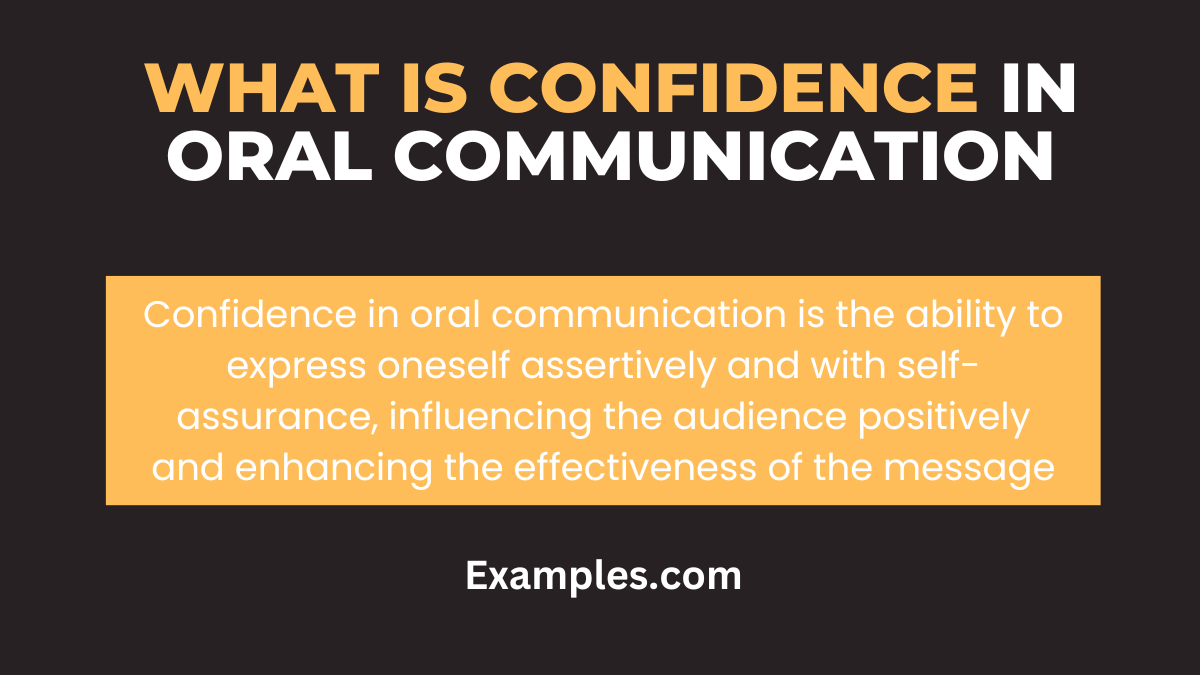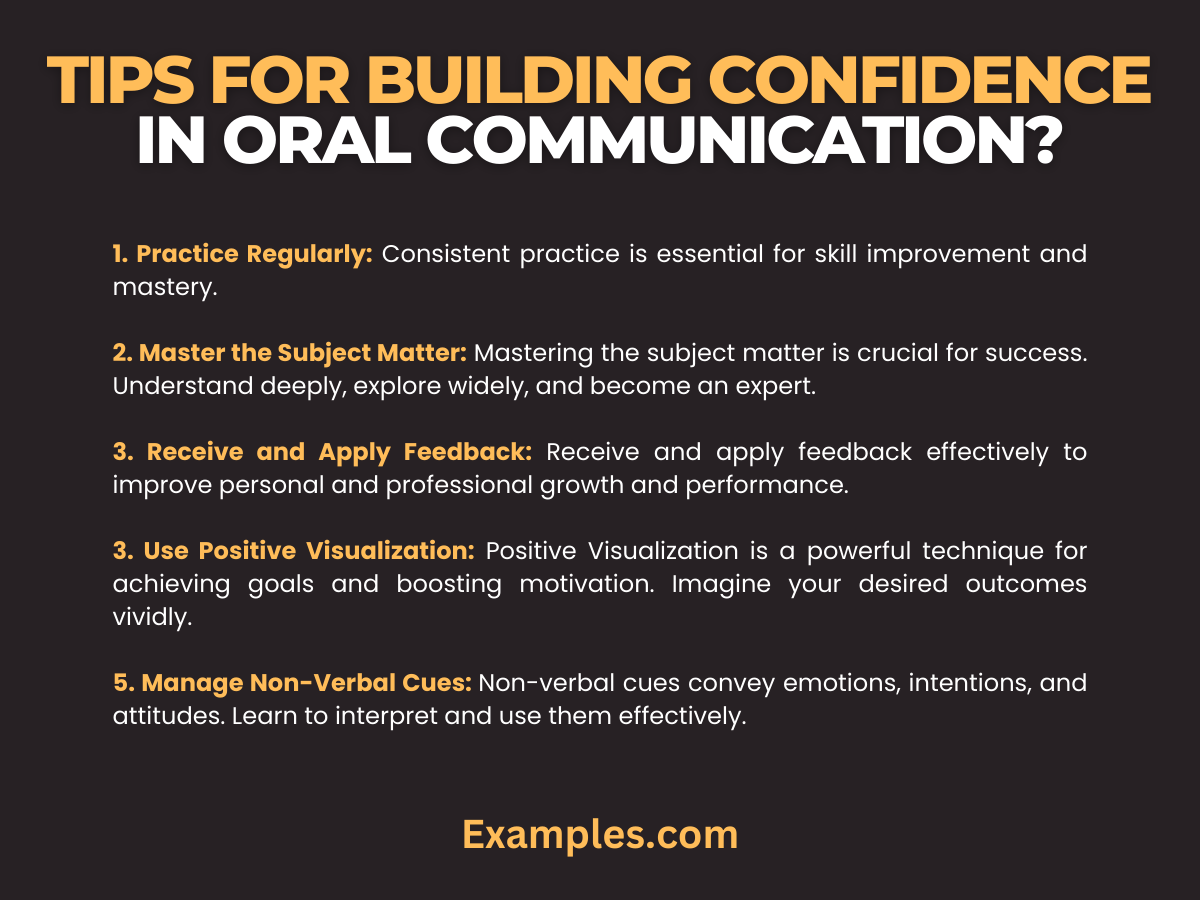19+ Confidence in Oral Communication Examples
Confidence in oral communication is pivotal in both personal and professional spheres. This guide provides comprehensive strategies to enhance your speaking abilities, ensuring your words make an impactful impression. Whether you’re addressing a large audience or engaging in a one-on-one conversation, mastering the art of confident communication is crucial. We’ll explore various aspects such as body language, tone, and clarity, helping you deliver your message with assertiveness and poise. Embrace the power of effective communication and transform your interactions today.
What is Confidence in Oral Communication?

Confidence in oral communication refers to the ability to convey thoughts, ideas, and emotions clearly and persuasively in spoken form. It’s not just about what you say, but how you say it. This confidence stems from a blend of preparation, understanding your audience, and believing in your own message. It enables you to present your ideas assertively, engage your listeners, and respond to feedback dynamically.
What is the Best Example of Confidence in Oral Communication
The best example of confidence in oral communication can be seen in effective public speakers. They exhibit a strong presence, articulate their points clearly, and connect with their audience emotionally. These speakers use a combination of active listening and knowing their audience to tailor their message, ensuring it resonates well. Their confidence is evident in their controlled tone, concise messaging, and engaging storytelling.
20 Examples of Confidence in Oral Communication
Confidence in oral communication is a vital skill, encompassing clear articulation, engaging storytelling, and effective interaction with audiences. It requires understanding the nuances of language and body language to convey messages compellingly.
- “Instead of saying ‘I think we should,’ assertively state ‘I recommend we should’ to show certainty.” This change in phrasing demonstrates confidence and decision-making ability.
- “When asked a question, pause briefly to gather your thoughts instead of rushing into a response.” This shows you value thoughtful communication.
- “Utilize stories to make your presentations more relatable and memorable.” Storytelling in communication helps create a connection with the audience.
- “During meetings, maintain eye contact with participants to show engagement and confidence.” Eye contact is a key aspect of assertive communication.
- “Replace filler words like ‘um’ and ‘like’ with pauses, giving your speech more clarity and power.” This enhances the impact of your message.
- “In discussions, actively listen and nod to show understanding and engagement.” Active listening is crucial for effective communication.
- “Use gestures to emphasize points in your presentation, making it more dynamic and engaging.” Body language can reinforce verbal messages.
- “Start conversations with a firm handshake and a smile to set a positive, confident tone.” First impressions in communication are crucial.
- “Speak with varied intonation to keep your audience interested and convey enthusiasm.” Monotone speeches can be disengaging.
- “When giving feedback, be direct yet empathetic to maintain clarity and positive relations.” Effective feedback is a key communication skill.
- “In public speaking, practice your speech to reduce anxiety and increase confidence.” Preparation is essential for confident communication.
- “Ask open-ended questions to invite more detailed responses and engagement.” This fosters a two-way communication flow.
- “Use concise language to make your point clearly and avoid confusion.” Brevity can make communication more effective.
- “Adapt your message to suit the understanding level of your audience for better engagement.” Tailoring messages is key in diverse settings.
- “Avoid technical jargon in general conversations to ensure clarity and comprehension.” Simple language can be more impactful.
- “Use positive language to create a constructive and encouraging communication environment.” Positivity can influence audience reception.
- “When faced with criticism, respond calmly and constructively, showing emotional intelligence.” Handling criticism well is a sign of communication strength.
- “In team discussions, encourage quieter members to share their views, demonstrating inclusive leadership.” This shows respect for all voices.
- “Regularly seek feedback on your communication style for continuous improvement.” Self-awareness in communication is vital.
- “End your communications with a clear summary or call-to-action to reinforce your message.” Concluding effectively ensures message retention.
Why Confidence is Important in Oral Communication?
1. Enhances Clarity of Message: Confident speakers communicate their points more effectively. When you speak with confidence, your message is clear, reducing misunderstandings and misinterpretations.
2. Builds Credibility: Confidence in oral communication helps establish your credibility. Audiences are more likely to trust and believe in what you say if you deliver your message confidently.
3. Facilitates Engagement: A confident speaker is more engaging. Your confidence can captivate your audience, keeping them interested and attentive to your message.
4. Improves Persuasion Skills: When trying to persuade or influence others, confidence is key. A confident tone can make your arguments more compelling.
5. Reduces Anxiety: Confidence in speaking can help reduce anxiety and nervousness, common barriers to effective communication.
6. Encourages Feedback: Confidence invites interaction and feedback from the audience, making communication a two-way process. It opens the door for constructive dialogues and discussions.
Tips for Building Confidence in Oral Communication?

1. Practice Regularly: Like any skill, confidence in oral communication improves with practice. Rehearse your speeches or presentations to become more familiar with the content.
2. Master the Subject Matter: Understand your topic thoroughly. In-depth knowledge can significantly boost your confidence, as you feel prepared to handle questions and discussions.
3. Receive and Apply Feedback: Constructive feedback is invaluable. Seek it out and use it to refine your communication skills.
4. Use Positive Visualization: Visualize yourself communicating effectively. Positive imagery can build your confidence before you even begin speaking.
5. Manage Non-Verbal Cues: Pay attention to your body language. Maintaining good posture, making eye contact, and using appropriate gestures can reinforce your confidence.
6. Start with Smaller Groups: Begin by speaking in front of smaller, more familiar audiences. As your confidence grows, gradually increase the size and unfamiliarity of your audience.
In conclusion, developing confidence in oral communication is a multifaceted process that goes beyond mere speech delivery. It encompasses a comprehensive understanding of the subject matter, awareness of one’s non-verbal cues, and a genuine connection with the audience. Confidence in speaking can transform the way we interact, negotiate, and lead in various aspects of life, from personal interactions to professional engagements. To further enhance your skills in this area, consider exploring additional resources such as Harvard University’s tips on public speaking and Toastmasters International, a renowned global organization dedicated to improving communication and leadership skills. These platforms offer valuable insights and techniques to refine your oral communication skills, ensuring you deliver your message with clarity, conviction, and confidence.



